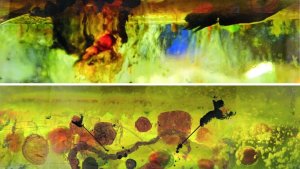Presented By: A. Alfred Taubman College of Architecture + Urban Planning
The University of Michigan Presents Lecture: Rachel Armstrong

Rachel Armstrong is Professor of Experimental Architecture at the School of Architecture, Planning and Landscape, Newcastle University. She is a Rising Waters II Fellow with the Robert Rauschenberg Foundation (April-May 2016), TWOTY futurist 2015, Fellow of the British Interplanetary Society, a 2010 Senior TED Fellow and profiled in the RIBA Journal, 2018. She is Director and founder of the Experimental Architecture Group (EAG) whose work has been published widely as well as exhibited and performed at the Venice Art and Architecture Biennales, the Tallinn Architecture Biennale, the Trondheim Art Biennale, the Palais de Tokyo (Paris), the Institute of Advanced Architecture, Catalonia (IAAC), Aarhus Kuntshal, the University of the Underground (Amsterdam), The Gallatin School, New York University, Allenheads Contemporary Arts, and Culture Lab at Newcastle University.
Her work investigates a new approach to building materials called ‘living architecture,’ which suggests it is possible for our buildings to share some of the properties of living systems. Collaboratively working across disciplines, she builds and develops prototypes that couple the computational properties of the natural world with matter at far from equilibrium. She calls the synthesis that occurs between these systems and their inhabitants “living” architecture.
She is coordinator for the €3.2m Living Architecture project, which is an ongoing collaboration of experts from the universities of Newcastle, UK, the West of England (UWE Bristol), Trento, Italy, the Spanish National Research Council in Madrid, LIQUIFER Systems Group, Vienna, Austria and EXPLORA, Venice, Italy that began in April 2016 and runs to April 2019. It is envisioned as a next-generation, selectively, programmable bioreactor that is capable of extracting valuable resources from sunlight, wastewater and air and in turn, generating oxygen, proteins and biomass. Conceived as a freestanding partition it is composed of bioreactor building blocks (microbial fuel cell, algae bioreactor and a genetically modified processor), which are being developed as standardized building segments, or bricks. Living Architecture uses the standard principles of both photo bioreactor and microbial fuel cell technologies, which are adapted to and combined into a single, sequential hybrid bioreactor system so they will work synergistically together to clean wastewater, generate oxygen, provide electrical power and generate useable biomass (fertilizer)
Co-sponsor: University of Michigan Biosciences Initiative
Her work investigates a new approach to building materials called ‘living architecture,’ which suggests it is possible for our buildings to share some of the properties of living systems. Collaboratively working across disciplines, she builds and develops prototypes that couple the computational properties of the natural world with matter at far from equilibrium. She calls the synthesis that occurs between these systems and their inhabitants “living” architecture.
She is coordinator for the €3.2m Living Architecture project, which is an ongoing collaboration of experts from the universities of Newcastle, UK, the West of England (UWE Bristol), Trento, Italy, the Spanish National Research Council in Madrid, LIQUIFER Systems Group, Vienna, Austria and EXPLORA, Venice, Italy that began in April 2016 and runs to April 2019. It is envisioned as a next-generation, selectively, programmable bioreactor that is capable of extracting valuable resources from sunlight, wastewater and air and in turn, generating oxygen, proteins and biomass. Conceived as a freestanding partition it is composed of bioreactor building blocks (microbial fuel cell, algae bioreactor and a genetically modified processor), which are being developed as standardized building segments, or bricks. Living Architecture uses the standard principles of both photo bioreactor and microbial fuel cell technologies, which are adapted to and combined into a single, sequential hybrid bioreactor system so they will work synergistically together to clean wastewater, generate oxygen, provide electrical power and generate useable biomass (fertilizer)
Co-sponsor: University of Michigan Biosciences Initiative